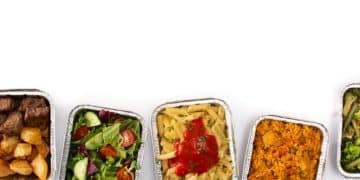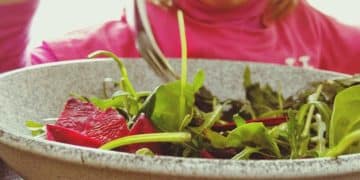Healthy family meal planning tips for your busy schedule

Healthy family meal planning tips involve engaging your family in meal preparation, incorporating nutritious ingredients, and creating a fun atmosphere to cultivate better eating habits together.
Healthy family meal planning tips can make a real difference in how your family enjoys mealtime and stays nourished. Have you ever felt overwhelmed at dinner time? Let’s dive into some straightforward strategies to simplify this process.
Understanding the importance of meal planning
Understanding the importance of meal planning can transform your family’s eating habits significantly. By organizing meals in advance, families can enjoy nutritious options that fit their busy schedules without the stress of last-minute decisions.
Benefits of Meal Planning
When you plan your meals, you’re not just saving time; you’re also gaining control over your family’s nutrition. Here are some key benefits:
- Reduces food waste by using ingredients effectively.
- Helps in maintaining a balanced diet with varied meals.
- Simplifies grocery shopping and budgeting.
Meal planning also encourages healthier choices. With a plan in place, you’re less likely to reach for unhealthy snacks or fast food when you feel hungry. Instead, having a clear plan makes it easy to prepare meals that include fruits, vegetables, and lean proteins.
Saving Time and Money
Another important aspect is how meal planning can save you time and money. By prepping meals ahead of time, you can save yourself those hectic weekday dinners. Imagine coming home after a long day and knowing exactly what you will eat!
Additionally, meal planning helps you utilize your grocery budget more effectively. By purchasing only what you need for your planned meals, it minimizes impulse buys that can lead to overspending.
Embracing meal planning is a step toward a healthier lifestyle for your family, creating an opportunity to bond during preparation, and encouraging everyone to be involved in food choices. In this way, meal planning can be a fun family activity, fostering a sense of teamwork and shared responsibility.
Tips for creating a weekly meal plan

Creating a weekly meal plan is easier than you might think. With just a few tips, you can streamline your cooking process and ensure your family enjoys healthy meals. Starting with a clear vision can make a significant difference.
Assess Your Family’s Needs
Before creating your meal plan, consider your family’s preferences and dietary requirements. Each member may have different likes and dislikes, so it’s essential to involve everyone. This way, you can plan meals that everyone will enjoy.
- Check for food allergies and preferences.
- Incorporate a variety of protein sources.
- Include meals for busy days and slower ones.
Once you know what works, it makes planning easier and more effective. You can also utilize family favorites in your weekly meal plan. Having common dishes helps simplify shopping and cooking.
Plan Ahead with a Template
Using a meal planning template makes the process smoother. Write down your meals for each day and any snacks. A template can take many forms—digital tools, printable charts, or pen and paper. Whatever works best for you, stick with that.
Having a visual layout allows you to see your meals at a glance. It can also help ensure balance throughout the week, making sure everyone gets their fair share of fruits and vegetables.
Make a Shopping List
Once your meals are planned, it’s time to create a shopping list. Group your list by categories such as produce, dairy, and meats to save time while shopping.
- Check your pantry and fridge before shopping.
- Write down ingredients needed for each meal.
- Include staples you may be running low on.
A well-prepared list reduces the chances of forgetting essential items and encourages you to stick to your meal plan. You’ll feel accomplished knowing you have everything you need for the week.
Engaging in this planning process together turns it into a family activity, making mealtime not just about the food but about quality time spent together. As you implement these tips, you’ll find that planning meals becomes easier and more enjoyable in no time.
Incorporating nutritious ingredients easily
Incorporating nutritious ingredients into your meals can be simple and straightforward. Understanding how to include healthy foods can greatly benefit your family’s overall well-being without making cooking a chore.
Start with Whole Foods
One of the best ways to add nutrition is by focusing on whole foods. These ingredients, such as fruits, vegetables, whole grains, and lean proteins, should be the foundation of your meals.
- Choose fresh or frozen fruits and vegetables to retain nutrients.
- Include whole grains like brown rice and quinoa.
- Opt for lean meats, fish, or plant-based proteins.
Whole foods are packed with vitamins, minerals, and fiber, which support overall health. Making these a staple in your grocery list makes it easier to prepare nutritious meals.
Mix and Match Ingredients
Combining different ingredients can create varied and delicious meals. Start with a base, then layer on proteins and vegetables. This method not only keeps meals interesting but also enhances nutrition.
You could try mixing leafy greens with beans for added protein. Combine colorful veggies in your stir-fry for an eye-catching appearance. Adjust your meals based on what’s fresh and in season to maximize flavor and health benefits.
Use Healthy Swaps
Making simple ingredient swaps can also help increase nutrition. For instance, substitute whole grain pasta for regular pasta or use Greek yogurt instead of sour cream. These small changes can significantly boost the nutritional profile of your meals.
- Replace regular cheese with low-fat options.
- Use avocado instead of mayonnaise for spreads.
- Choose natural sweeteners like honey or maple syrup over refined sugars.
These modifications do not only enhance nutrition but can also introduce new flavors that your family will love. Finding creative ways to substitute products can make meal prep both fun and healthy.
Implementing these strategies allows your family to enjoy their meals while benefiting from nutritious choices. With a little creativity, incorporating healthy ingredients becomes second nature.
Engaging your family in meal preparation

Engaging your family in meal preparation can make cooking more enjoyable and foster a sense of teamwork. When everyone contributes, it not only lightens the load but also creates lasting memories and encourages healthy eating habits.
Assigning Roles
Start by assigning roles based on age and skill level. Younger children can wash vegetables or stir ingredients, while older kids can help with chopping and measuring. This inclusion allows each family member to feel valued and important in the process.
- Have kids pick out ingredients at the grocery store.
- Designate a family member as the head chef for each meal.
- Rotate responsibilities weekly to keep things fresh.
Making everyone involved can also spark interest in trying new foods. If kids help prepare a dish, they are more likely to eat it enthusiastically.
Make it Fun and Educational
Cooking together can be a fun opportunity for learning. Use meal prep time to teach your kids about nutrition, food safety, and cooking techniques. Explain the importance of healthy eating and how different ingredients can help their bodies.
Use creative themes for your meals, such as “Taco Night” or “Pasta Party.” Allowing kids to choose themes not only makes cooking fun but also gives them a chance to express their culinary creativity.
Incorporate Family Traditions
Incorporating family traditions into meal prep brings a sense of history and culture to your cooking. Share recipes that have been passed down through generations and explain their significance. This will deepen your family’s connection to food.
- Share the stories behind family recipes.
- Recreate traditional meals together on special occasions.
- Encourage family members to contribute their favorite dishes.
By engaging your family in meal preparation, you can turn cooking into a shared experience that everyone looks forward to. It builds strong family bonds, promotes healthier eating, and allows you to create delicious meals together.
FAQ – Frequently Asked Questions about Family Meal Preparation
How can I get my kids involved in cooking?
You can assign simple tasks like washing vegetables or stirring ingredients. It’s fun and educational for them.
What are some benefits of meal prepping as a family?
Meal prepping together strengthens family bonds, promotes teamwork, and encourages healthier eating habits.
How do I choose healthier ingredients for meals?
Focus on whole foods like fruits, vegetables, whole grains, and lean proteins. These are packed with nutrients.
What are some fun themes for family meals?
You can have themed nights like Taco Tuesday or Pasta Night to make meal prep more enjoyable for everyone.





